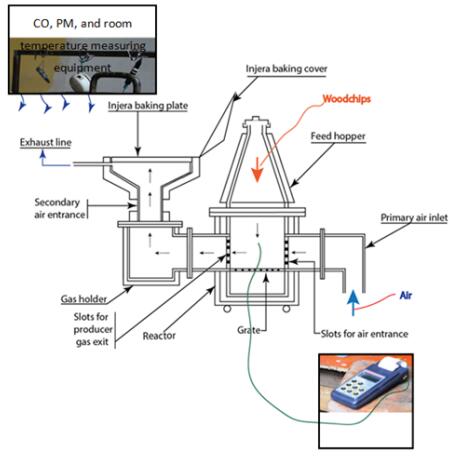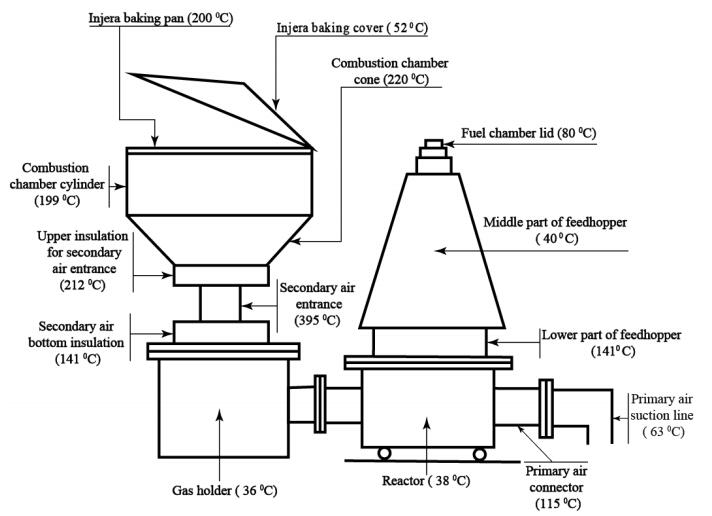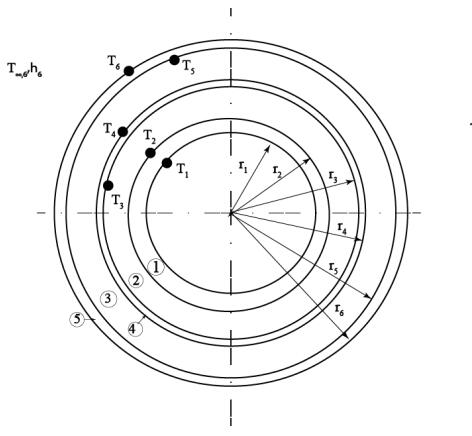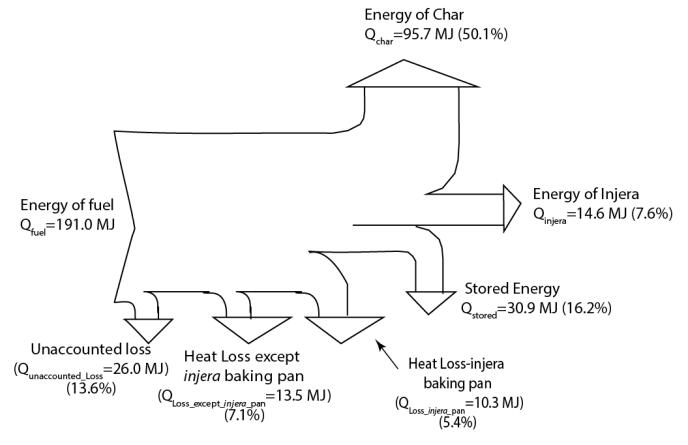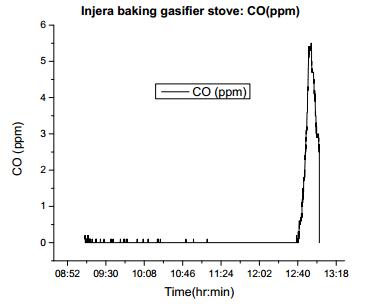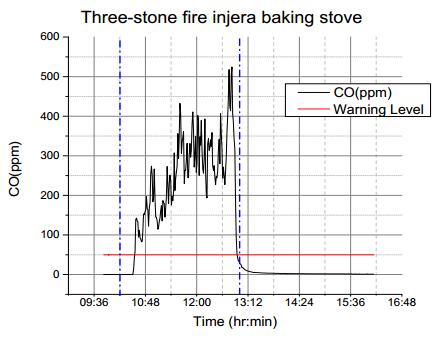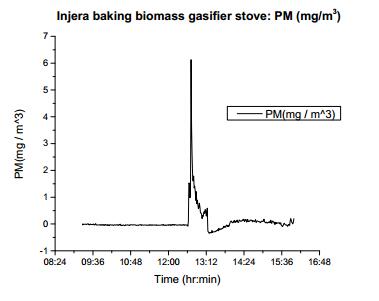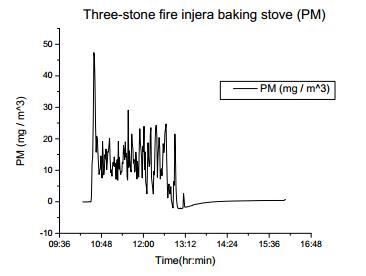Nearly 40% of the world population use biomass as their primary energy source, especially for cooking; but traditional and inefficient three-stone fires cause serious health issues and their high fuel consumption leads to deforestation problems. Ethiopian cuisine is mainly based on vegetable and meat dishes in the form of a thick stew, served on top of injera, a large sourdough flatbread made out of fermented teff flour. Injera is known for its energy intensive and time consuming baking. It has remained rarely researched for alternative energy sources, although some improved biomass firing stoves have been introduced in the Ethiopian market. Thus, there is a need for a new efficient and clean stove that can drastically reduce the fuel consumption, emissions and indoor air pollution. In the present manuscript, the first injera biomass gasification baking stove is presented and its performance reported. A thermal efficiency of 16% is achieved, the specific fuel consumption is reduced by 12.8% , and baking time reduced by 19% compared with the three-stone fire. CO (Carbon Monoxide) and PM (Particulate matter) emissions are reduced, compared to the three-stone fire, by 99% and 87%, respectively. Heat losses and stored heat in the system are also calculated. Results show that it is possible to increase the efficiency and reduce the fuel consumption if the insulation is improved, the heating up time between consecutive baked injeras reduced and longer injera baking sessions, like in community kitchens, promoted. This first successful attempt to bake injera using a biomass gasifier stove in the eastern part of Africa shows promising result and can lead to an efficient and clean biomass gasifier stove that could be widely disseminated for injera baking.
Nomenclature: ρ: density of the materials (kg/m3); ηth: thermal efficiency; A: heat transfer area (m2); Cp: specific heat capacity (kJ/kg.K); fd: equivalent fuel wood (g); ff: final weight of fuel (wood chips) (g); fi: initial weight of fuel (wood chips) (g); h1: convection heat transfer coefficient (W/m2.K); r: radius from the center (m); hfg: latent heat of vaporization of water (kJ/kg.K); HVchar: heating value of char (kJ/kg); HVfuel: heating value of fuel (kJ/kg); k: thermal conductivity of materials (W/m.K); L: length (m); m: moisture content of fuel (%); mchar: amount of char produced (kg); mevap: amount of water evaporated during injera baking [mbatter-minjera] (kg); mfuel: amount of fuel consumed (kg); minjera: mass of injera baked (kg); p: mass of empty 'sefied' plate (g); pf: mass of 'sefied' plate with baked injera (g); Qconv_cond: heat loss due to convection and conduction (kW); Qr: rate of radiation heat transfer (kW); Qstored: rate of thermal heat storage (kW); T: average temperature of injera during baking (℃); T1, T2…T6: surface temperature (℃), the subindex denotes the surface according to Figure 5; Tbatter: temperature of batter (℃); Tboil: boiling temperature of water (℃); Ts: surface temperature in absolute scale (K); Tsur: surrounding temperature in absolute scale (K); V: volume of materials (m3); Wf: net weight of food (g); Xm: moisture content of injera (%); ΔCc: mass of remaining char (g); ΔT: temperature difference (℃); ε: emissivity of the surface; σ: Stefan-Boltzmann constant (Ϭ = 5.67 x 10-8 W/m2 K4)
Abbreviations: ASTM: American Society of Testing and Materials; CCT: Controlled Cooking Test; CO: Carbon Monoxide; EPA: Environmental Protection Agency; GIZ-ECO: Deutsche Gesellschaft fur Internationale Zusammenarbeit—Energy Coordination Office; IBBGS: Injera Baking Biomass Gasifier Stove; IEA: International Energy Agency; PM: Particulate Matter; RTFD: Royal Thai and Forestry Department; SFC: Specific Fuel Consumption; UNFCCC: United Nations Framework Convention on Climate Change; WBT: Water Boiling Test; WFP: World Food Program; WHO: World Health Organization
1.
Introduction
Globally, there are approximately 1.2 billion people without access to electricity, and 4 billion people who rely on biomass for cooking [1]. The traditional and inefficient use of biomass creates a number of significant problems which include an estimated 4 million of annual deaths attributed to the negative health effects associated with indoor air pollution. More than 50% of the premature deaths of children below 5 years are caused by the presence of particulate matter in their kitchen because of the use of biomass [1]. In Ethiopia, the national electrification rate is around 25% [2]; being 85% in the urban areas and 10% in the rural areas [2]. So, it is expected that Ethiopia will depend on biomass as a primary energy source for quite a number of years to come [3].
In developing countries, most people use three-stone fires for cooking or baking applications. When used indoors, these biomass cooking stoves lead to severe health issues because the smoke is vented into the home and pollutants concentration increases due to inadequately ventilated rooms causing chronic lung diseases, acute respiratory problems as well as vision problems. The main victims are usually women and young children, who are often carried on the mother's back while cooking. These traditional wood fires also imply a high risk of burns and scalds especially on children. Furthermore, because the heat is allowed to escape into the open air rather than heating the cooking vessel, three-stone fires have a low thermal efficiency of around 10% [4]. This implies a high fuel consumption which results in an increase of the amount of wood harvested and related deforestation.
A number of efforts are underway to improve the performance of traditional biomass cooking stoves. In early stages of development, the focus was on improving specific parts of the stove such as the grate, skirt and insulation. However, nowadays, researches focus on reducing the emissions and increase the energy efficiency. For this reason, 'gasifier' or 'pyrolytic' stoves are receiving more attention [5].
Biomass gasification is the thermochemical conversion process where a partial oxidation of biomass takes place and a gas phase and a solid phase are produced. The solid phase includes char and the inert material present in the biomass (ash). The gas phase is a combustible gas and can be used for power generation or biofuel production. The combustible gas produced, when using air as gasifying agent, consists mainly of CO, H2, CH4, CO2 and N2 [6]. However, the actual gas composition may vary considerably depending on fuel type and gasifier design. People living in rural areas of developing countries cannot afford buying forced draft or advanced biomass gasifier stoves, therefore research on natural draft gasifier stoves is prioritized [7]. Small-scale gasifier stoves are getting popular and considered the future clean cooking stoves due to their benefits in terms of smoke and soot free clean combustion [7]. Biomass gasification based cooking systems have also some other attractive advantages like high efficiency, uniform and steady flame, ease of flame control, and possible attention-free operation over extended duration [6]. Several hundred biomass gasifier cooking stoves are already in operation in countries such as China and India [6,8]. The possibilities and benefits of biomass gasification technology for cooking and baking applications are leading to a number of initiatives to introduce them in developing countries.
Injera, a circular pancake or flat-bread with a diameter of 52 cm and 2–4 mm thick, is the national dish in Ethiopia and Eritrea. Injera is made with teff flour mixed with water and allowed to ferment for several days, as with sourdough starter. It can also be made from wheat, barley, maize, sorghum, or from a mixture of them [9]. The prepared flat-bread is porous, soft, thin, and sour-tasting. In order to prepare injera, a ceramic plate called mitad is required to be placed on top of the biomass stove [10,11]. Injera is known for its energy intensive and time consuming cooking. Traditionally, injera has been baked using three-stone fires. However, in Ethiopia, improved biomass cooking stoves were introduced in the early 1980s to reduce deforestation and indoor air pollution [12]. Comparing all the different types of improved biomass stoves developed earlier except the biogas injera baking stove, all the other improved biomass injera baking stoves are enclosed and some designs also include the option of sauce or stew heating using a pot or kettle [13]. The design most commonly used is the Mirt stove [14] but there is no injera biomass gasification baking stove available in the Ethiopian market. Despite these efforts to develop better stoves, injera baking process has remained rarely researched for alternative energy sources. For this reason, there is a real need to develop an attractive and efficient alternative to conventional wood stoves that could be used in institutional kitchens and rural communities.
Authors conducted a research study to investigate already existing gasifier reactor designs for cooking stoves and to select one that could be adapted for injera baking [13]. The natural cross-draft gasifier stove (IGS-2) designed at the Asian Institute of Technology under the Renewable Energy Technologies in Asia: A Regional Research and Dissemination Programme (RETs in Asia) [15,16] was selected. The gasifier stove was initially designed for rice cooking in two pots [17]. The IGS-2 Gasifier stove was tested with different kind of fuels to evaluate its versatility and efficiency. An average efficiency of 17% with rice husk briquettes (two-pot configuration), 27% with wood chips and 22% with wood twigs was obtained [15]. The design was disseminated in the six Asian countries involved in the RETs in Asia regional programme resulting in modified and improved designs for different applications [18,19,20].
The present manuscript presents the first prototype of injera baking biomass gasification stove. The modifications and improvements done to the original IGS-2 design are described together with the results of the tests carried out to evaluate its thermal efficiency, fuel consumption, emissions and indoor air pollution. The successful production and distribution of an injera baking biomass gasification stove in Ethiopia would represent a clean and efficient energy supply for cooking to avoid the problems caused by traditional use of biomass and would also reduce the risk of deforestation.
2.
Materials and method
2.1. Fuel characterization
The feedstock used for the experiment was eucalyptus tree wood cut into small pieces and sun dried for at least three to four weeks to reduce the moisture content to 5–6% (wb). This type of wood is commonly used for injera baking in rural areas of Ethiopia. Table 1 shows the characteristics of the wood, experimentally determined at Geological Survey of Ethiopia according to ASTM standard [21].
2.2. Experimental set-up: Injera baking biomass gasifier stove
The design of the injera baking biomass gasifier stove is based on the IGS-2 biomass gasifier design for institutional cooking developed at the Asian Institute of Technology [15,16]. It is a natural cross-draft gasifier stove (Figures 1 and 2) made using 2.5 mm thick mild steel sheet metal. It consists of four main parts: feed hopper, reactor, primary air inlet and combustion chamber. The different parts are attached together using bolts and nuts.
The feed hopper is located above the reactor and conically shaped to facilitate the movement of woodchips down to the reactor. It is closed with a lid for easy loading of biomass and has a water seal to avoid gas leakage during the operation. The feed hopper is connected to the upper part of the reactor and the fuel moves down to the reactor by gravity. The reactor is a cylindrical body 2.5 mm thick, 400 mm diameter and 350 mm height. A grid placed in the reactor holds the biomass but allows the ashes to fall free through it. The ashes accumulated can be removed by opening a steel door located under the grate. The primary air inlet is an inverted 'L' shaped unit attached to the side of the reactor. The amount of primary air supplied to the reactor is controlled by a butterfly valve. Perforated steel sheets are used at the primary air inlet and exit areas to keep the fuel inside the reactor. A flange connects the producer gas outlet and the combustion chamber. The combustion chamber has a cylindrical shape and then it opens up in a conical structure to accommodate the ceramic pan (mitad). The cylindrical burner is equipped with a secondary air inlet sieve-like structure with a diameter of 150 mm. The reactor, feed hopper, gasholder, combustion unit and secondary air inlet sections are insulated using 50 mm thick fiberglass and covered with aluminum sheets. The injera baking cover is a standard item made of aluminum with a wooden holder at the edge.
2.3. Experimental procedure
The teff dough used for making injera was prepared well in advance and left to ferment for 4 to 5 days with some left over batter from the previous baking session. Tests started by weighing the biomass introduced in the feed hopper and opening the primary air flap and ignition /ash removal door to start the ignition. The water sealing cover of the feed hopper was also opened to facilitate the initial combustion. A flame torch was used to ignite the fuel from below the grate through the ash removal opening. The startup usually takes around 10 min. After this time, the gas produced started to flow to the combustion chamber where it could be ignited using a flame torch. Once ignited, the baking pan (mitad) was placed on top of the combustion unit. Ground rapeseeds were used to oil the mitad when it was hot enough. When the ground rapeseed started to get burned, they were wiped off to pour the batter on the clay pan. Half minute after pouring the batter, the cover was closed and the injera was cooked for 3 minutes before taking it out from the baking pan. This procedure was repeated to bake 25–30 pieces of injera which is the usual amount baked per session for a single household in Ethiopia.
The controlled cooking test protocol was used to determine the specific fuel consumption and baking time [22]. The batter bucket and the sefied (plate used to remove and pile up the injeras) were weighted before starting the test. When the test was finished, all stove openings were closed and the stove was allowed to cool down for a day. The ash from the ash container, the remaining unburned biomass and injeras produced and piled up on the seified were weighed to obtain the net amount of injeras produced and fuel used during the baking session.
Tests were carried out in a typical Ethiopian kitchen of 2 m × 2 m × 2.5 m. The reactor temperature was measured with a thermocouple connected to a data logger and the surface temperature was measured using an infrared thermometer. According to the recommendations of the University of California [23], the instruments used for measuring carbon monoxide, particulate matter and room temperature were placed 100 cm from the edge of the combustion zone, at a height of 145 cm from the floor and 150 cm away from openable doors. CO was measured using EL-USB-CO data logger (Lascar Electronics Inc., USA) with an accuracy of ± 7 ppm. Room temperature was measured using EL-USB-TC-LCD (Lascar Electronics Inc., USA) with an accuracy of ± 1 ℃ and particulate matter was measured using UCB-PATS (Berkeley Air Monitoring Group, USA).
2.4. Performance calculations
Energy utilized for baking injera
The amount of energy used to bake injera is a combination of sensible and latent heat used to evaporate the water and bake the injera to the required quality. The mass of evaporated water can be obtained from the difference between the initial weight of batter and the final baked injera [24]. The energy utilized to bake injera (Qinjera) is computed by using Eq 1.
Specific fuel consumption
The specific fuel consumption (SFC) is the amount of fuel consumed per unit of food cooked, in g per kg, calculated according to the controlled cooking stove testing protocol [22]. Equations 2 and 3 and 4 were used to calculate the equivalent fuel wood (fd), net weight of food (Wf) and SFC:
Thermal efficiency
The thermal efficiencies of both three-stone fire and injera baking biomass gasifier stove were calculated as the ratio of useful energy to the net energy input. The thermal efficiency was calculated using Eq 5:
The specific heat capacity of injera is obtained from Eq 6 considering 70 percent water and 30 percent teff flour in the injera [25].
1 T in this equation is in ℃.
Heat losses
Figure 3 shows the surface temperature of the injera baking gasifier stove measured using infrared thermometer. These temperature measurements were conducted for each of the components such as feed hopper, reactor, gas holder, secondary air entrance, combustion chamber and injera baking pan and cover. In order to estimate the heat losses from the Injera Baking Biomass Gasifier Stove (IBBGS), the measured surface temperatures and measured/assumed inside gas temperatures were used in the computation (Table 2).
Conduction and convection heat transfer loss
The construction of most of the components ofthe gasifier stove is based on different layers such as carbon steel, gypsum, fiber glass and aluminum cover, Figure 4 shows a representative figure for all the components. Thus, assuming interfacial contact resistances to be minimal, the heat transfer rate, which is a combination of conduction and convection is computed using Eq 7.
Radiation Heat Loss
The net thermal radiation loss from the components of IBBGS surface to the surrounding was calculated by using Eq 8.
Heat Storage Capacity
The thermal energy stored in the injera baking biomass gasifier stove was estimated based on dividing the whole part into sub-components which includes: feed hopper, reactor, gas holder, secondary air insulation, combustion chamber and injera baking pan. Equation 9 was used to calculate the estimated thermal energy storage capacity of each component.
2 ΔT is the temperature difference between the inside gas and surface temperature
3.
Results and Discussion
The injera baking process is not like any other cooking process where a pot is placed and the ingredients boiled; instead, batter is poured on a hot clay pan at 180–220 ℃ [24]. A number of tests were performed to see the functionality of the first design of the injera baking biomass gasifier stove. Here, a representative data set from three of the tests is presented to show its performance.
Assuming the average temperature of baking (i.e. starting at 20 ℃ and evaporation of the water at 92 ℃) which was 56 ℃ have been considered for calculating the specific heat capacity of injera/batter which is 3.4 kJ/kg.K. Thus, the average amount of energy required to bake a single session injera baking which was 30 injera become 14.6 MJ (Table 3).
Considering the injera baking biomass gasifier stove as a control volume, the energy balance of the system was carried out. Figure 5 shows the energy input, lost and useful energy generated during the injera baking process.
3.1. Thermal efficiency
The thermal efficiency of the present injera baking biomass gasifier stove was 16% while the efficiency of the three-stone fire for injera baking was 8% (Table 3). This shows an increase of the efficiency of around 100% compared to the three-stone fire. These results are slightly lower but in good agreement with those presented by other authors. Bhattacharya and Leon [15] tested the original IGS-2 stove design and found an average efficiency of 17% using rice husk briquettes (two-pot configuration), 27% using wood chips and 22% using wood twigs. Panwar and Rathore [26] tested another biomass gasifier stove designed for woody biomass and achieved a thermal efficiency of 26.5%. Belonio [27] tested a gasifier stove using rice husk as a feedstock and obtained a thermal efficiency of 27%. The lower efficiency found for the injera baking biomass gasifier stove could be explained because of the differences between the injera baking process and the water boiling process. During the injera baking process, 35% of the total baking time is used for heating up because higher temperatures in the mitad are needed (180–220 ℃) when compared with boiling water. Thus, the amount of heat lost through the baking pan during the heat up time between baking two consecutive injera is probably responsible for the lower efficiency. In order to calculate the specific heat capacity of injera, moisture content of injera was considered to be 70% [25].
3.1.1. Heat losses
Conduction and convection heat losses
In order to obtain the amount of convection and conduction heat transfer from the gasifier stove, Equation 7 has been used to obtain the value for each component and summed up to get the total heat loss due to convection and conduction. In this calculation, the temperature inside the gasifier stove and surface temperature (Table 2) was used as basic parameters. The unit in consideration can have composite materials such as carbon steel, gypsum, fiber-glass, and aluminum or some of the above materials. The thermo-physical properties of each material with their respective heat transfer area are calculated to obtain the thermal resistance in series for each material. Using the stated equation, the amount of energy lost due to convection and conduction was calculated separately and summed up. The rate equation is changed into energy loss using the average working time of the gasifier stove. Thus, the estimated total energy lost due to convection and conduction becomes 19.3 MJ.
Radiation heat transfer
Since the gasifier stove's surface temperature varies throughout the body, the heat loss due to radiation was another point of consideration. Using Eq 8 where emissivity of each materials, surface and surrounding temperatures (Table 2) were used to estimate the total rate of radiation loss from the gasifier stove. The rate of energy loss was converted into radiation energy loss using the operation time of the gasifier stove. Therefore, the total amount of radiation energy lost from the gasifier stove was estimated to be 4.48 MJ.
Heat loss calculations of the biomass gasifier stove components showed that insulation played a major role to increase the efficiency and avoid the heat losses. The estimated heat losses which consist of conduction, convection and radiation during the injera baking process including the unaccounted losses were around 49.8 MJ and it is believed that additional insulation could further minimize these heat losses. The injera baking pan is responsible for part of the heat losses (10.3 MJ) that occur mainly during the heating up interval between baking two consecutive injeras. As previously mentioned, 35% of the total baking time is used for heating up the baking pan to the right temperature (180–220 ℃). Earlier studies also confirmed that the heat up time should be reduced to increase the thermal efficiency of injera baking devices [28]. In addition to the baking pan, the combustion chamber, reactor and primary air inlet present the highest heat losses. The minimization of these heat losses is a priority for future improvements of the design.
3.1.2. Thermal storage capacity
The thermal energy stored in the gasifier stove was calculated using Eq 9. In this computation, for each material, the density, volume including surface and inside gas temperatures of the gasifier stove (Table 2) were used to calculate the total amount of energy stored in the system.
In addition to heat losses, heat energy was stored in various components of the injera baking biomass gasifier stove. The component that stored more than 90% of the thermal energy was the reactor. The reactor has double insulation using gypsum and fiber glass at the outer part of the unit. Table 4 shows the amount of energy stored in each component. The already existing biomass injera baking stoves have comparatively less thermal storage capacity than the gasifier stove. Thus, the injera baking biomass gasifier stove is expected to increase in performance with increasing the number of injera baked per session [11,28].
3.2. Specific Fuel Consumption
The amount of fuel consumed per injera baked was calculated and compared with a three stone-fire under the same conditions. The results showed that the specific fuel consumption (SFC) of the three-stone fire was 1217 g of fuel/kg of injera and that of the biomass gasifier stove on average was 1061 g fuel/kg of injera (Table 5). This means a 12.8% reduction on the specific fuel consumption. It is important to bear in mind that the test was conducted for 25–30 injeras and the initial heat absorbed by the apparatus is high. As stated by other researchers, there is a decrease in the specific fuel consumption when increasing the number of injeras baked per session [11]. These authors suggest that the promotion of longer injera baking sessions like in community kitchens may lead to additional fuel wood savings. This is an interesting concept if household size and baking sessions decrease in future due to urbanization and family planning [29]. So, the present design would have a much lower specific fuel consumption if operated at a larger scale e.g. 1000 injera per day.
3.3. Baking time
The time required for baking injera was considered as a comparison parameter for determining the stove performance. On average, the time to bake a single injera was 3.83 min for the biomass gasifier stove, while it took 4.74 min for a three-stone fire. As a result, a 19% reduction of baking time was achieved. For other improved injera biomass baking stoves, authors have reported from increases of 7% of the baking time [30] to reductions of 5% [31], 7% [32], 15% [33] and 17% [34]. Thus, the reduction achieved with the present design is reasonably high compared with other biomass based stoves for the same application.
3.4. Indoor air pollution from the biomass gasifier baking stove
3.4.1. Carbon monoxide concentration
According to the World Health Organization, the acceptable amount of carbon monoxide during 1 hour of exposure is 30 ppm [35]. The concentration monitored during the baking session with the injera biomass gasifier stove reached a maximum of 5.5 ppm (Figure 6) which is significantly lower than the 525 ppm from the three-stone fire (Figure 7). A value of 7.2 ppm was reported for the Mirt injera baking stove [30]. BhattacharyaAlbina and Myint Khaing [36] studied the effects of different parameters (fuel moisture content, size of fuel, size of pot and method of ignition) on performance and emissions of three biomass stoves (an improved Indian stove, a Vietnamese traditional stove and an improved stove developed by RTFD). They observed a reduction of efficiency and an increase of the CO emissions when increasing the fuel moisture content. The most favorable CO emission values that they observe during their tests was 19.3 ppm for the RTFD stove. In light of these results, the present injera baking biomass gasifier design achieves a drastic reduction of CO concentration values compared with the three-stone fire and lower values than those reported for other improved biomass based cooking stoves.
3.4.2. Particulate matter concentration
The amount of soot or particulate matter (PM) existing in a kitchen has an impact on the health of people in the room. The maximum recorded PM concentration during the baking session with the present gasifier stove design was 6.13 mg/m3 (Figure 8). This value is well below the WHO standards that recommend concentrations below 10 mg/m3 for annual exposure and 25 mg/m3 during 24 hours exposure (WHO 2010). As shown in Figure 9, the maximum PM recorded during injera baking using a three-stone fire was around 47.4 mg/m3. Based on these maximum values, the percentage of improvement of the injera baking biomass gasifier stove is 87% compared to the three-stone fire. MacCarty et al. (2010) reported that a properly functioning gasifier stove can reduce PM by 90% compared to three-stone fire.
4.
Conclusion
Majority of people living in developing countries use biomass for cooking and baking, and injera baking is one of the main cooking activities undertaken in the eastern part of Africa, especially in Ethiopia and Eritrea. This manuscript presents the first biomass injera baking gasifier stove designed. Its performance is compared with that of a three-stone fire usually used for injera baking. The PM and CO emission reductions when using the gasifier stove for baking injera showed a remarkable improvement of 87 and 99%, respectively. The average thermal efficiency achieved was around 16% which is higher than three-stone fire (8%). Heat losses in the components of the biomass gasifier stove were calculated and the baking pan proved to be responsible for 21% of the total heat loss. The thermal storage capacity of the components was also studied and showed that 90% of the energy stored in the system was in the reactor. These results showed that there is room for improvement by further reducing the heat losses from the stove, heat up time between consecutive baked injeras and by increasing the number of injeras baked per session. This first attempt to develop an injera baking biomass gasifier stove achieved promising results and, if improved and widely distributed, it could contribute to reduce deforestation, emissions and health problems caused by elevated concentrations of pollutants in the kitchen when using inefficient three-stone fires.
Acknowledgments
Authors would like to thank Addis Ababa University (AAU) for funding the present study and for covering all the expenses during the external stay at Technical University of Denmark (DTU). Authors would also show their gratitude to the members of Biomass Gasification Group at the Chemical Engineering Department of DTU who provided insight and expertise that greatly assisted the research. In addition, authors would like to thank the Federal Democratic Republic of Ethiopia (FDRE), Ministry of Water, Irrigation and Electricity, and Ethio Resource Group (ERG) PLC for lending the instruments which we used for various measurements during the testing period.
Conflict of Interest
All authors declare no conflict of interest in this paper.









 DownLoad:
DownLoad:
